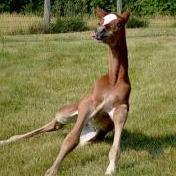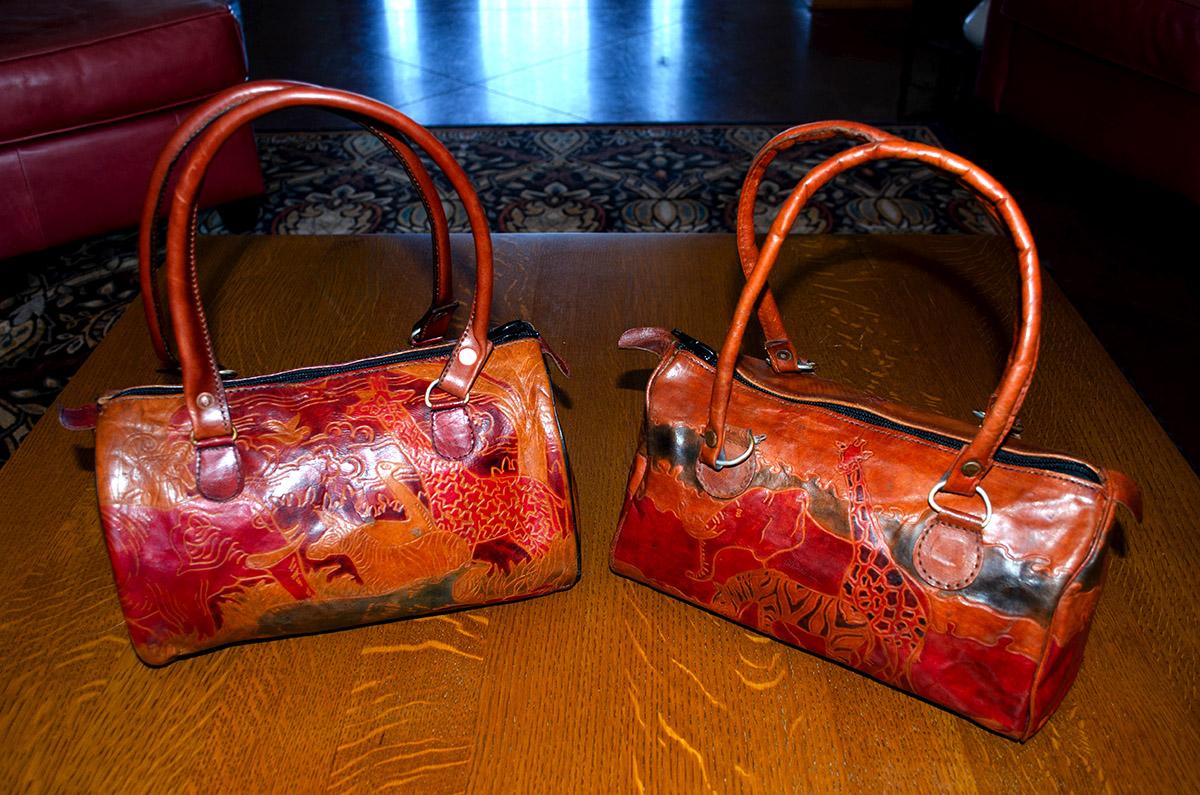-
Posts
1,287 -
Joined
-
Last visited
Content Type
Profiles
Forums
Events
Blogs
Gallery
Everything posted by TomE
-
I've been happy with Weaver's stitching horse. This video just came across my feed. https://youtu.be/Y6VdzFQATEw?si=jBoQWbfggn9BiLd8
-

Choosing durable dog collar thread... linen, Nylex etc...?
TomE replied to LakeOtter's topic in Sewing Leather
Tapering the end of the thread works for heavy linen thread, but not for synthetics. For linen I wax the thread, ends and all, after making the tapered ends. The wax will help keep the thread from slipping through the eye of the needle. However, most of my hand sewing is done with bonded nylon thread from my sewing machine. For hand sewing I wax the nylon thread and rub the wax with heavy wrapping paper to smooth it out. I use waxed polyester thread (0.04" = 1 mm) from the Maine Thread Co for some heavier jobs like sewing billets on a saddle. For that task I double the thread, tie a knot in the end, and use a single needle backstitch instead of a saddle stitch. -
I refill a Barge quart can from a gallon can, adding Barge thinner as needed. Made a funnel from a 16 oz plastic bottle. What is everyone's favorite glue pot?
-
I've been using a heat gun to "activate" contact cement - just a brief warming of the glued pieces before assembly. Bonds well with less cement so I have fewer problems with the glue interfering with burnishing edges. For some shaped pieces I case the leather lightly and shape the leather before applying the glue, and the heat gun treatment results in a better bond when the leather is damp. I'm using Barge cement but will probably switch to Weldwood in the future.
-
Spent some quality time with my patcher sewing these purses back together. The leather was dry, the cotton (?) thread was deteriorating, and the plastic piping was cracking. It was a learning experience. I replaced the zipper on both purses and made new rolled leather handles for one of them. I'm thinking it's easier to make bags than repair them. Maybe I will test that idea.
-
Good looking leads and collars! I like the way you sewed the chapes on the ends of the rope leads. You are motivating me to make a leather collar for our new border collie rescue. He arrived a week ago and we've been his foster home until today when the mandatory hold on adoption is over and we can officially claim him as our own. We have another border collie who is teaching him how to (mis)behave around the farm.
-
The Chicago screws are a good idea - for the next one. This older client's saddle was in good shape, and I am guessing that she had taken a break from riding and was returning to it.
-
I recently encountered double cap rivets on the webs of a 25+ year old dressage saddle that was stamped Continental Walsall England. My online search didn't turn up anything specific about a maker. The client was the original owner of the saddle and I believe these were the original billets. The billets were machine sewn and I suggested that the rivets weren't necessary with hand sewn billets. She wanted the rivets. I guess they look strong. I used #9 copper rivets.
-
That's some serious stitching! Well done.
-
They might have come by the manual honestly from their Chinese friends who make the Cobra machines. Glad we're all on the same page. You got a bargain.
-
That's a beauty! I am still making friends with my patcher but find it is very handy for repairs. It seems reasonably forgiving of my lack of experience with it. Have fun. Here's the manual for the Cobra 29-18 patcher. https://cdn.shopify.com/s/files/1/0631/4000/3933/files/29-18_Manual.pdf?v=1747672941
-
I used to mess with cars before I resumed leatherwork. I had good luck with these products for leather interiors. https://www.griotsgarage.com (couldn't embed the full link to leather care products, but you can search the site for "leather"). Now I would probably clean the seats with glycerin saddle soap and a wet sponge, rinsing the sponge often to remove dirt and excess soap. While the seats are damp I would apply a cream conditioner like Bickmore's Bick 4. If that didn't restore the seats to your satisfaction then I'd find an upholstery shop to recover them.
-
Most of my hand sewing is using #207 bonded nylon that I wax. If fact, I always re-wax waxed thread before use because the wax is usually dry and flaky. I use a cobbler's wax that is a mix of beeswax and pine resin. After waxing I burnish the thread with a piece of heavy brown wrapping paper to even out the wax.
-
I've been happy with the chrome tanned billet bends from Naudin and Booth. https://boothandco.com/products/booth-saddle-strap-leather-rawhide-cow-billet The leather is stiff with little stretch. I believe it is tanned by Thomas Ware and Sons in Bristol. Perhaps it is available from UK suppliers? It seems that dressage saddles have a wide range of billet lengths and hole patterns that I like to match. My personal record is 33" billets on a Hermes saddle.
-
For me the type of strap cutter I use depends on the thickness and width of the strap. I use an inexpensive wooden strap cutter for thin leather (<7 oz) and narrow straps (3/8"-1"). The wooden strap cutter is also handy for cutting straps from small pieces of leather. Abbey England sells one that is as good as any I've purchased in the USA. I do sharpen and strop the blade, holding it with a surgical needle holder (heavy duty hemostat). For 6-12 oz straps that are 1/2"- 1" wide I use a draw gauge. @bruce johnson has some nice draw gauges that are ready to use, and a tutorial on his website about how to hold the draw gauge. For heavy and wide straps (> 3/4") I use a plough gauge that I bought from Vergez Blanchard. I did spend some time reworking the angle of the knife blade (~15 deg) and I put a small bevel on the back side of the knife to keep it from pinching the strap excessively against the gauge. It is my go-to tool for cutting lots of straps from a side of 9-10 oz leather.
-
Yes, lots of trends to follow, and with social media everyone's an expert.
-
But the shoe polish fixed everything. Her responses to the comments tell the story.
-
Lots of good choices for your projects. The Cobra Class 26 is a popular machine and there are a fair number of lightly used machines available on FB marketplace, Craigslist, etc. I bought one in like new condition several years ago and figure it will hold its value. It is quite handy for medium to lightweight projects.
-
Ideally the crank, like any noseband, simply helps to keep the bridle in place. However, it can be (over)tightened to prevent the horse from opening its jaw and evading the bit. I am less familiar with how curb straps are used.
-
Thank you, @Tove09Tilda for your kind words. Welcome to the forum. Hope to see your work here. For the dee rings, these are a bit heavier than needed and I welcome ideas about different designs to pad them. I have seen a crank using a small ring with a tab that was buried between the end of the strap and the padding. It appeared that the tab had a slot and the stitching was placed into the slot to secure the ring. The underlying padding extended past the ring, similar to what you described, but it was a short overhang that looked tidy. I haven't found this type of ring/tab/slot at my usual hardware suppliers.
-
I have increased the foot pressure and switched to white thread. This seems to have fixed the problem with skipping stitches. I ordered thread lube and a pot, and hope to switch back to stiffer black thread with lubrication. I am figuring out how to feed Biothane while sewing close to hardware. For leather halters I typically add a wedge/welt to ease the transition in thickness and sew tight to the hardware. Biothane is stiff and springy when folded around hardware so it's a new experience negotiating the ends of the straps. The feet want to slip back down the slope as the material compresses while sewing on a slope. Beta biothane is a matt finish and relatively grippy compared to bridle leather, but the flattening of the loops as they are sewn is a new dynamic for me. Thanks for the reminder, Tim. I will check the needle/hook distance. I am settling on a size 24/25 needle, which is what I've been using for leather (cutting point, not round point) on this machine without any issues.
-
This guy says subtract an inch from your measurement for gusset length. Some day I'll test this using my heap of leftovers from bridle sides but I currently have no experience with bag making.
-
For me, the key was learning to get the knives really sharp with a ~15 deg bevel. I am mainly skiving veg tanned leathers. I place the leather on plate glass with a bit of beeswax rubbed on the glass to grip the leather because I am working on small pieces that are difficult to grip while skiving an edge. That cheap Chinese knife from Amazon does a reasonable job when kept sharp. I've been meaning to learn how to use a safety skiver and this Don Gonzales video has some tips. He also notes (in another video?) that the blade should move diagonally along the edge when skiving, not straight down the beveled edge.
-
I had a size 26 needle installed when checking the timing, and I haven't previously noticed any problems with switching needle sizes. To my knowledge, there is no shimming of the shuttle on this 441 clone. I set the hook timing 3 years ago following the same procedure and it's been working fine for leather. I rechecked it yesterday and made some minor changes. Sews fine with leather and one layer of Biothane. The missed stitches occur erratically so I am thinking it's friction and/or how I am feeding material through the machine. Thank you, Wiz. Lots of good information. I am using black thread from LMC and it is considerably stiffer than other colors. I will test out white thread and fiddle with the foot pressure and check spring tension. Guess I will order a lube pot and lube to find out what that's all about. We mostly use Biothane halters in our barns. They used to affordably priced with stainless hardware, but the prices have risen considerably so I decided to make some for us and friends. Not interested in large scale production of this item and competing on price with bigger vendors. I definitely like sewing leather better than Biothane but this is a good learning experience for me.



